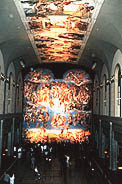SPRING PALETTE:
Art Museums Offer a Fresh Look
April 19, 1999

The Otsuka Museum boasts "environmental displays"--replicating
not only the works of art but their original surroundings as well. (Otsuka
Museum of Art)
The majority of Japan's art museums feature works of modern Western
art. But with over 300 museums around the nation, the market for this
type of work is now saturated. In order to continue attracting visitors
it has become necessary for these institutions to offer fresh themes
and be more selective about the works they present. This spring's lineup
of newly opened museums offers just such a fresh approach.
New Themes
The Fukuoka Asian Arts Museum, which opened March 6, 1999, claims to
be the world's first to focus on early modern and modern Asian art.
The museum was born out of a series of exhibitions held once every five
years at the Fukuoka Arts Museum to showcase Asia's top modern-day artists.
Having easy access to the rest of Asia, the museum amassed a considerable
collection of Asian art--to the point where it decided to establish
a separate museum devoted to these works. The new museum will be an
innovative operation providing trained volunteers to give detailed explanations
and guided tours, compile materials on the exhibits, and even create
Web sites featuring the artists and their work.
The Shimane
Art Museum, located in the city of Matsue near beautiful Shinji
lake, also opened to the public on March 6. Its collections are appropriate
to its setting in that they feature works by a wide range of artists
revolving around a single theme--water. With pieces by many famous artists,
including Claude Monet's The Needle and the Gate of Aval and
Gustave Courbet's The Mill at Scey-en-Varais, the exhibition
is sure to be a hit.
One museum already making headlines is the Nagoya/Boston
Museum of Fine Arts, which opened on April 17, 1999. This institution
will be a sister branch of the Boston Museum of Fine Arts in the United
States, famous for its collection of impressionist paintings. As this
is the Boston institution's first international "sister museum" relationship,
it is already attracting media attention around the world. The Nagoya
branch has a 20-year contract with the Boston museum that will give
it access to the latter's vast store of work for numerous long- and
short-term showings. The opening exhibition runs through September 26
and features landscapes by such impressionists as Monet and Renoir.
The many famous works featured are sure to draw big crowds.
Theme Museums
Another unique museum, slated to open in April in Onomichi, Hiroshima
Prefecture, came about in an unusual fashion. In an effort to halt construction
of a high-rise apartment building that would have blighted the area's
scenic landscape, citizens raised funds and purchased the land intended
for the building, where they erected the museum. The Onomichi museum
will re-create the residence of Western-style painter Ryuzaburo Umehara
(1888-1986), an influential member of the Shirakaba (White Birch) school
active in the first half of the twentieth century. A local art dealer
is pitching in to help the museum assemble a strong collection of Shirakaba
school works.
In May a former work space of world-renowned sculptor Isamu Noguchi
(1904-88) will be opened to the public in Mure, Kagawa Prefecture, as
an outdoor museum. In order to preserve the quality of the works still
stored there visitors will be limited to around 60 per day.
Better than the Real Thing?
Perhaps the most unique museum to appear over the last few years is
the Otsuka Museum of Art in Naruto, Tokushima Prefecture. The museum,
which opened in March 1998, gained permission from holding institutions
around the world to replicate the images of 1,000 of the world's most
well-known works, including the Mona Lisa. Using a special photo technique
developed by a chemical company, the images were imprinted onto ceramic
boards, resulting in exact, original-sized replicas that visitors can
actually lay their hands on without any deterioration to the works.
The museum has also sought to make the decor surrounding the works close
to that where the originals are on display. A similar museum is being
planned in Ibaraki Prefecture for a fall 2004 opening that will feature
replicas of some of the most famous images from Japanese art.
 Edited
by Japan Echo Inc. based on domestic Japanese news sources. Articles presented
here are offered for reference purposes and do not necessarily represent
the policy or views of the Japanese Government.
| 











